VK Activator Stats – Part 3
by vk3arr
Because it seems I have nothing better to do, and people are interested, I decided to dig a bit deeper into the retention/churn dimension discussed in the last post and continue the analysis started here. At some point I’ll actually get around to updating my blog with tales of my own activations, rather than data on everyone elses 😀
First, let’s define a new activator as someone who has their first activation in a particular year. Let’s then define an old activator as someone who has had their last activation in a particular year. By definition, this is taken at the end of the year, so for 2017, there are no old activators yet.
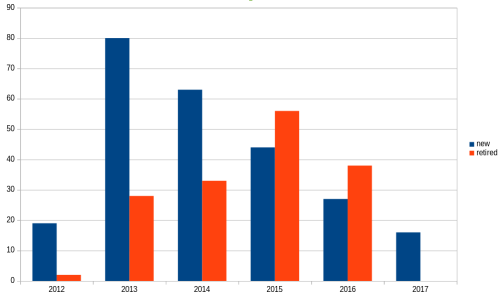
All VK new versus old activators
Unsurprisingly, there’s a big increase in new activators early in the SOTA program’s history in VK, and once we hit 2015, this rate slows down dramatically, and is overtaken by people who have, by our definition, ‘left SOTA’.
I acknowledge that a person who last activated in 2016 and hasn’t activated in 2017 yet will be counted as an old activator, but 7 months of inactivity isn’t an unrealistic definition, and so I am comfortable with the statistics as they currently stand.
From this, we can calculate net retention rates. I’ve chosen the new year as an arbitrary cutover date of our ‘subscription’, but while this analysis could be done for any particular date, I’m pretty happy the results will not dramatically change the analysis.
To calculate retention, we take the total number of activators last year, then calculate the total number of activators at the end of the next year. This is last year’s figure, plus the new activators this year, minus the old activators. We compare the ratio of this year to last year to get our retention rate.
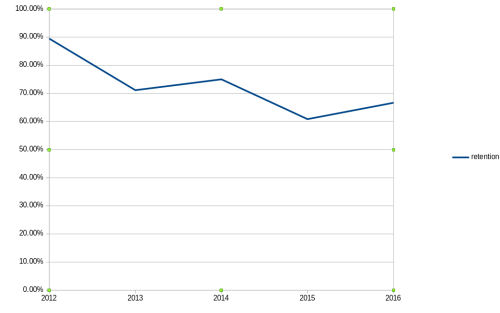
Calculated retention rate over all VK
As can be seen, a steady decline, with a little bit of noise in the data. This one is probably the more concerning one for me given the long term trend. No analysis has been performed on why, but the original post speculates.
I was then asked by Grant VK4JAZ about splitting by association. This isn’t easy as people can change association, but based on their stated “Home Association” in the database, the stats are as follows:
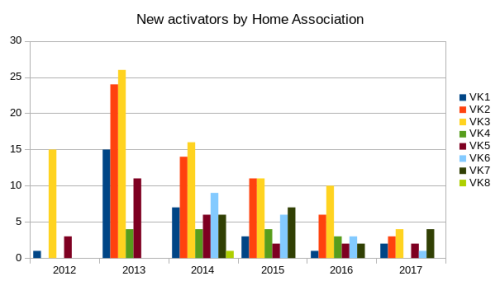
Activators by year and home association for date of first activation
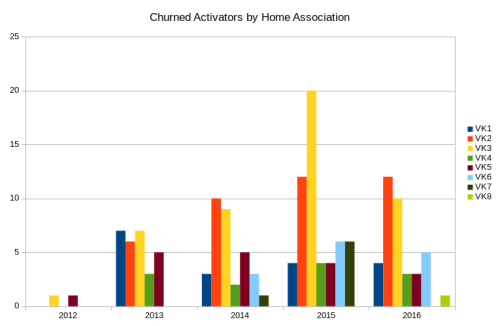
Activators by home assocation and year based on date of last activation
From these, and using the same methodology above, we can track, by VK association, the total number of active activators:
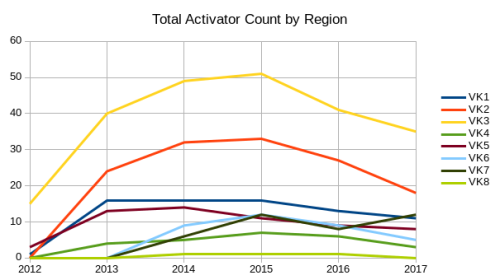
Total activator count – calculated as total activators last year, plus new activators this year minus old activators last year
This suggests that, apart from VK7, all associations have seen decreases in activators and activity since each association kicked off. It remains to be seen if this could be called a plateau, or if it’s a genuine decrease. The retention rate figures suggest its a decrease.
I ‘Like-d’ this post for your analysis, not for its message. The Sotawatch database stats roughly correlate with the decrease in Yahoo group activity. Thanks for shedding some light.
No problem. It’s easy when you have access to the underlying data and a penchant for statistics that borders on fetishistic.
We are of course ignoring chasers, which enables more people to participate who, hip replacement or not, are not able or have no desire to climb mountains – even the drive ups.
I think where the allure of the activation has correlation with solar cycle is around the speed of an activation. I’ve noticed it become harder to get contacts compared with when I started, when you could have 4 in the logs quicker than you could write, almost. My last few activations have required some serious patience – not my strong suit.
In short, an activation isn’t as fun as it once was because the dopamine rush as you work 40 stations and a ton of DX is harder to find or no longer there. Hence one strategy probably has to be moving away from mid-HF bands to other more lucrative ones – 6m, UHF and above, 80, 160m and below.
But, the millenials, fed on a diet of dopamine through Instagram likes and “third best trier” encouragement awards (get off my lawn!), will need different strategies. Pokemon Go, Ingress and other augmented reality games have shown there’s a market there if we can find a way to give them that rush.
Good comments. Andrew VK1AD is leading as usual on this by gearing up on 1296 and dragging some others up there. A new band, particularly one very different from where you’ve been, is as good as a holiday!
Let’s face the truth. The program has reached a mature state in VK. This year in VK1 we have introduced two newcomers, which in part offsets two others who have almost dropped out. Meanwhile a regular activator from mid 2016, who went AWOL for 12 months, has reenergised to rejoin the 2017 effort. Newcomers to VK1 have a direct correlation to the number of ‘Contact Me’ hits on my blog. Across Australia we need more SOTA blog posts. AR mag by itself is a poor recruitment tool, it’s preaching to the converted. The millennials are online 🙂
I agree. To borrow a business term again, our total addressable market – the number of hams who are below the age of 75 and still have their original hips and/or knees – is a small fraction of the ham population in VK, ageing and declining at similar or sharper rates than SOTA. I’ve made no attempt to quantify what percentage of that market we have involved in SOTA. [1]
Maybe we can’t dramatically increase the number of people involved because they just aren’t there? We’d be foolish not to try, though. I know you’ve already been doing a lot of this locally, but if we got you involved more in the publicity side globally, would you be interested?
[1] Bringing people into AR via SOTA is a related but temporarily ignored point 🙂
It would be interesting (perhaps informative) to see if there is a correlation between SOTA activity and VHF/UHF Field Day participation rates. My gut feeling is that a similar rate of decline will be noticed. I think what Andrew VK1AD is doing and the approach he is taking is excellent ie setting personal challenges involving 70cm or 23cm. This is sure to keep the passion alive.
Grant VK4JAZ